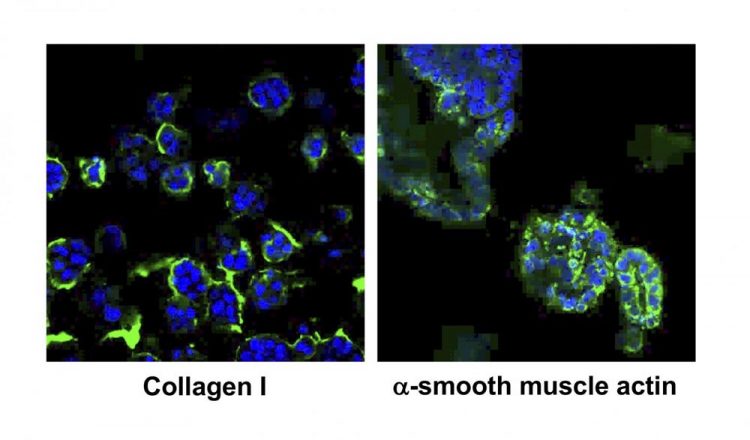New 3D cultured cells mimic the progress of NASH

Left panel: Expression of Collagen I protein in green indicates that fibrosis, one of the NASH characters, is formed in the NASH organoids. DAPI staining in blue shows nuclie of cells. Right panel: Expression of alpha-Smooth muscle actin protein in green indicates that hepatic stellate cells were activated in the NASH organoids. This also represents one of the NASH characters. Credit: T. Usui / TUAT
In Japan, about 10 million of people (8% of the population) are thought to carry NASH or to be at high risk for NASH. In the USA, a ballpark estimate indicates about 3% to 12% of adults have NASH.
The NASH patients develop fatty liver regardless of alcohol intake and progress to liver cirrhosis or ultimately liver cancer. NASH symptoms include liver tissue inflammation, fat deposition, and fibrosis. Unfortunately, there are no medications available for treating NASH, thus this becomes a big social problem.
In general, to test which drugs could cure NASH, researchers used the method that experimental animals were fed by a NASH-inducing diet, followed by drugs were continuously given to these animals. It is, however, obvious that using experimental animals to test drugs is not practical.
“To mimic NASH in a dish, we started three-dimensionally growing cells that were collected from liver tissues of NASH model mice”, said Dr. Tatsuya Usui, corresponding author of the paper, Senior Assistant Professor, Laboratory of Veterinary Pharmacology, Department of Veterinary Medicine, Faculty of Agriculture, TUAT. “These cells successfully grew in a dish and formed mini-organs called organoids.”
For producing NASH organoids in a dish, we used cells from liver in the NASH mice with 3 different disease stages, such as the early stage (fatty liver), the middle stage (fatty liver), and the late stage (advanced fibrosis).
The organoids were examined by standard histology methods, such as HE staining, oil red staining, and Masson's trichrome staining to visualize cell shapes, oil production in cells, and connective issues, respectively. In addition, immuno-staining, quantitative PCR, RNA-sequencing were performed to see localization and amount of bio-markers.
“After careful scientific analyzes, we found that these cells' characters in the organoids were very similar to those of NASH liver tissues. Interestingly our NASH organoids also mimic characters of these stages. We therefore concluded that NASH was reproduced in a dish using the organoid culture method for the first time,” Usui explained.
“We expect that drug discovery targeted for each stage can be done using these organoids. In addition our RNA-sequencing analysis found that several genes were elevated at the all stages of organoids and some others were highly expressed at a specific state (patent application filed). So far, no effective diagnostic bio-markers have been found that accurately reflects the degree of progression of the NASH. Therefore, we expect that new reliable bio-markers for diagnosis can be identified using our NASH organoids”, added Usui.
###
This study was supported in part by a Grant-in-Aid for Mishima kaiun memorial foundation.
For more information about the Usui laboratory, please visit http://vet-pharmacol.
About Tokyo University of Agriculture and Technology (TUAT):
TUAT is a distinguished university in Japan dedicated to science and technology. TUAT focuses on agriculture and engineering that form the foundation of industry, and promotes education and research fields that incorporate them. Boasting a history of over 140 years since our founding in 1874, TUAT continues to boldly take on new challenges and steadily promote fields. With high ethics, TUAT fulfills social responsibility in the capacity of transmitting science and technology information towards the construction of a sustainable society where both human beings and nature can thrive in a symbiotic relationship. For more information, please visit http://www.
Original publication:
Efficacy of primary liver organoid culture from different stages of non-alcoholic steatohepatitis (NASH) mouse model.
Elbadawy M, Yamanaka M, Goto Y, Hayashi K, Tsunedomi R, Hazama S, Nagano H, Yoshida T, Shibutani M, Ichikawa R, Nakahara J, Omatsu T, Mizutani T, Katayama Y, Shinohara Y, Abugomaa A, Kaneda M, Yamawaki H, Usui T*, Sasaki K.
Biomaterials. 2020 Jan 27;237:119823.
*: corresponding author
doi: 10.1016/j.biomaterials.2020.119823
Contact:
Tatsuya Usui, DVM, PhD.
Senior Assistant Professor
Laboratory of Veterinary Pharmacology, Department of Veterinary Medicine, Faculty of Agriculture, TUAT, Japan
E-mail: fu7085@go.tuat.ac.jp
Media Contact
More Information:
http://dx.doi.org/10.1016/j.biomaterials.2020.119823All latest news from the category: Health and Medicine
This subject area encompasses research and studies in the field of human medicine.
Among the wide-ranging list of topics covered here are anesthesiology, anatomy, surgery, human genetics, hygiene and environmental medicine, internal medicine, neurology, pharmacology, physiology, urology and dental medicine.
Newest articles

A new puzzle piece for string theory research
Dr. Ksenia Fedosova from the Cluster of Excellence Mathematics Münster, along with an international research team, has proven a conjecture in string theory that physicists had proposed regarding certain equations….

Climate change can cause stress in herring larvae
The occurrence of multiple stressors undermines the acclimatisation strategies of juvenile herring: If larvae are exposed to several stress factors at the same time, their ability to respond to these…

Making high-yielding rice affordable and sustainable
Plant biologists show how two genes work together to trigger embryo formation in rice. Rice is a staple food crop for more than half the world’s population, but most farmers…



